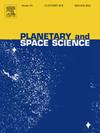Experimental investigation of solar radiation effects on Mercury’s surface regolith
IF 1.7
4区 物理与天体物理
Q3 ASTRONOMY & ASTROPHYSICS
引用次数: 0
Abstract
The surface of Mercury is exposed to extreme diurnal thermal variations caused by the high intensity of solar radiation, the radiative loss due to the planet’s lack of atmosphere, its eccentricity and its 3:2 spin - orbit resonance. This work presents an experimental study on terrestrial rocks used as Mercury analogues subjected to hermean conditions. We simulate the power density of a planetary surface at Mercury’s perihelion distance of 0.31 au using the Space and High-Irradiance Near-Sun Simulator (SHINeS) at Luleå University of Technology. The reflectance spectra were acquired in the visible and near-infrared wavelength range for every sample before and after irradiation. Permanent spectral changes are observed in all samples towards the longer wavelengths in the visible spectrum after only one thermal cycle. Darkening is evident in both the visible and near-infrared spectrum ranges, combined with reddening in the visible-to-near-infrared region in most of our samples. We propose that darker samples like boninite, basalt, and diorite are more likely to experience spectral changes due to their low albedo.
太阳辐射对水星表面风化层影响的实验研究
水星表面暴露在极端的日热变化中,这是由高强度的太阳辐射、由于地球缺乏大气层而造成的辐射损失、它的偏心和3:2的自旋轨道共振造成的。这项工作提出了一项实验研究,用于地球岩石作为水星类似物受到她的平均条件。我们利用吕勒堡理工大学的空间和高辐照度近太阳模拟器(shine)模拟了水星近日点距离为0.31 au的行星表面的功率密度。获得了辐照前后样品在可见光和近红外波段的反射光谱。经过一个热循环后,所有样品的可见光谱都向着较长波方向发生了永久性的光谱变化。在可见和近红外光谱范围内,变暗是明显的,在我们的大多数样品中,在可见到近红外区域结合变红。我们提出,较暗的样品,如博宁岩、玄武岩和闪长岩,由于它们的低反照率,更有可能经历光谱变化。
本文章由计算机程序翻译,如有差异,请以英文原文为准。
求助全文
约1分钟内获得全文
求助全文
来源期刊

Planetary and Space Science
地学天文-天文与天体物理
CiteScore
5.40
自引率
4.20%
发文量
126
审稿时长
15 weeks
期刊介绍:
Planetary and Space Science publishes original articles as well as short communications (letters). Ground-based and space-borne instrumentation and laboratory simulation of solar system processes are included. The following fields of planetary and solar system research are covered:
• Celestial mechanics, including dynamical evolution of the solar system, gravitational captures and resonances, relativistic effects, tracking and dynamics
• Cosmochemistry and origin, including all aspects of the formation and initial physical and chemical evolution of the solar system
• Terrestrial planets and satellites, including the physics of the interiors, geology and morphology of the surfaces, tectonics, mineralogy and dating
• Outer planets and satellites, including formation and evolution, remote sensing at all wavelengths and in situ measurements
• Planetary atmospheres, including formation and evolution, circulation and meteorology, boundary layers, remote sensing and laboratory simulation
• Planetary magnetospheres and ionospheres, including origin of magnetic fields, magnetospheric plasma and radiation belts, and their interaction with the sun, the solar wind and satellites
• Small bodies, dust and rings, including asteroids, comets and zodiacal light and their interaction with the solar radiation and the solar wind
• Exobiology, including origin of life, detection of planetary ecosystems and pre-biological phenomena in the solar system and laboratory simulations
• Extrasolar systems, including the detection and/or the detectability of exoplanets and planetary systems, their formation and evolution, the physical and chemical properties of the exoplanets
• History of planetary and space research
 求助内容:
求助内容: 应助结果提醒方式:
应助结果提醒方式:


